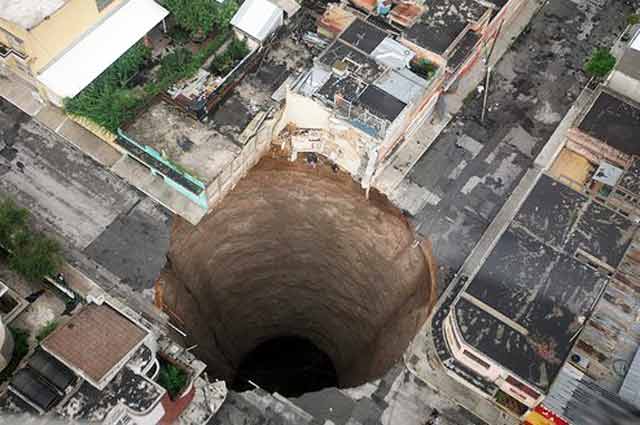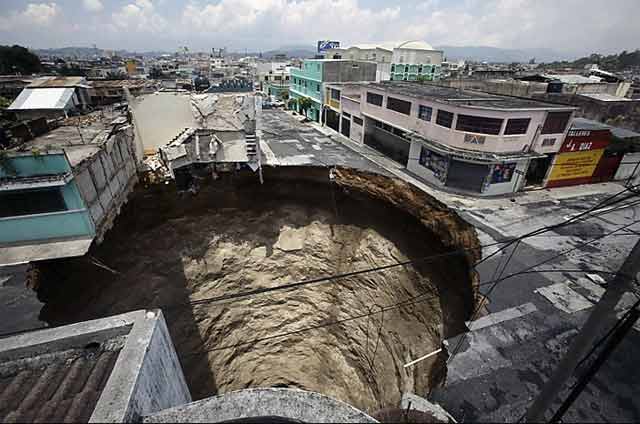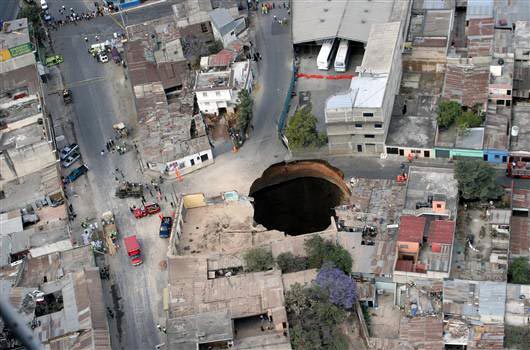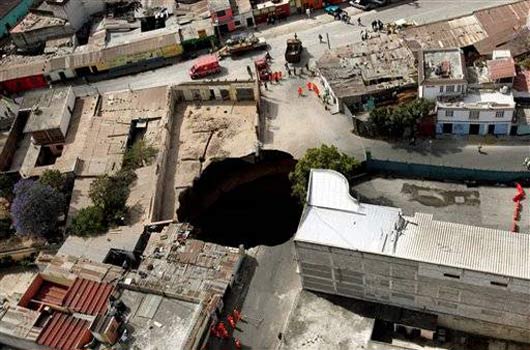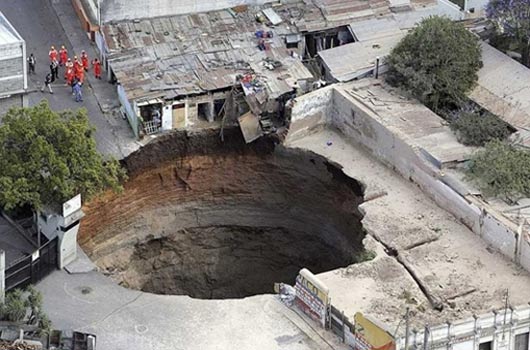Guatemala City Sinkholes
Punching a Hole in the EarthLife is a dream for the wise, a game for the fool, a comedy for the rich, a tragedy for the poor. - Sholom Aleichem You get tragedy where the tree, instead of bending, breaks. - Ludwig Wittgenstein This is common in limestone karst areas. Karst is limestone rock eaten away by runoff water which turns into sulfuric acid when combined with the rock, thus forming caves or sinkholes. Over half of the US is sitting on karst formations...
A three-story building in northern Guatemala City fell into a sinkhole in May 2010. Besides the sinkhole, during the same period, Guatemala experienced torrential rains triggering floods, 140 landslides, and falling boulders. To cap it all, Pacaya, a volcano just south of Guatemala City, erupted, blanketed the capital in ash, destroyed 800 homes, and forced the closing of the city's international airport.
A closer view of the May 2010 Guatemala sinkhole. It measured 66 feet across and 100 feet deep.
Source: jwz.livejournal.com This is an aerial view of the scene where a structure collapsed in Guatemala City 23 February 2007. A giant sinkhole swallowed several homes and at least one truck and officials said at least three people have been reported missing. Star / AP
Source: msnbc.msn.com Aerial view of the huge hole caused after a collapse in the sewage system in the neighbourhood of San Antonio, north of Guatemala city. Hundreds are being evacuated as a precaution against more possible collapses. ORLANDO SIERRA / AFP/Getty Images
Source: jwz.livejournal.com A 330-foot-deep sinkhole opened up before dawn, killing two teenage siblings, Irma and David Soyos, and their father Domingo Soyos, 53, when it swallowed about a dozen homes and forced the evacuation of nearly 1,000 people in a crowded Guatemala City neighbourhood. Officials blamed recent rains and an underground sewage flow from a ruptured main for the tragedy. The pit stank, growled and shook the surrounding ground. Water could be heard in the depths. Authorities fear it could widen or other sinkholes open up. Residents had heard noises and felt vibrations for weeks. Sources: jwz.livejournal.com 24 February 2007, shortarmguy.com Since this happened twice in three years, there's a greater risk that it could happen again. Geologist Sam Bonis, who worked in Guatemala's geographical institute for 16 years, claims that it may happen anywhere in the city. The Guatemala sinkholes of 2007 and 2010 caused some buildings to fall down, but relatively few people were hurt. However, that may just make it a matter of time before it happens in an area with more people. Source: associatedcontent.com See also:
For more articles relating to Money, Politics and Law including globalisation, tax avoidance, consumerism, credit cards, spending, contracts, trust, stocks, fraud, eugenics and more
click the "Up" button below to take you to the page on "How Many Countries in the World?" Clicking "Up" from there will take you to the Index for this section. |
 Animals
Animals Animation
Animation Art of Playing Cards
Art of Playing Cards Drugs
Drugs Education
Education Environment
Environment Flying
Flying History
History Humour
Humour Immigration
Immigration Info/Tech
Info/Tech Intellectual/Entertaining
Intellectual/Entertaining Lifestyles
Lifestyles Men
Men Money/Politics/Law
Money/Politics/Law New Jersey
New Jersey Odds and Oddities
Odds and Oddities Older & Under
Older & Under Photography
Photography Prisons
Prisons Relationships
Relationships Science
Science Social/Cultural
Social/Cultural Terrorism
Terrorism Wellington
Wellington Working
Working Zero Return Investment
Zero Return Investment